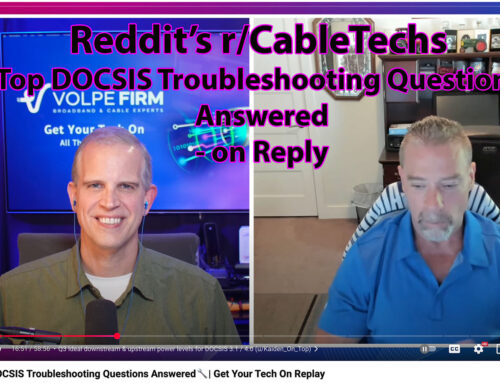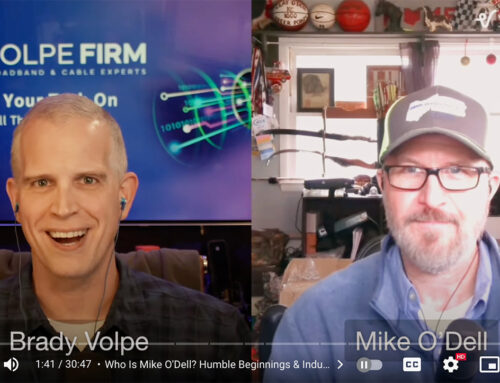DOCSIS 3.1 Beating Expectations, Working and Ready for Service Now
At this years SCTE Cable Tec Expo, several large MSOs, such as Comcast, made statements that DOCSIS 3.1 is working and it is working with great results. Only the downstream OFDM (orthogonal frequency division multiplexing) portion is currently supported in DOCSIS 3.1 CMTSs. Upstream OFDMA (orthogonal frequency division multiple access) is supported in the CPE side (aka cable modems), but only one CMTS vendor has support for upstream OFDMA. This is really not considered a show stopper, however. The proof in the pudding is demonstrating a production environment that DOCSIS 3.1 is living up to everything it was promised to deliver.
Great Expectations Met – High Order Modulations Work
Some operators are saying that the performance of DOCSIS 3.1 is proving to be better than they had expected. While many had doubted that high level modulations, such as 1024-QAM or even 4096-QAM could exist on our HFC plants, those who are deploying DOCSIS 3.1 in production systems are happy to see that these modulations are not only working, but actually working on modems and in areas where they did not expect such high performance.
When asked “what did they do prepare their plants for DOCSIS 3.1?”, the answer was simply “nothing”. You see if the plant already supports 256-QAM in the downstream, then it will support at least 1024-QAM DOCSIS 3.1 OFDM signals in the downstream. This is due to the smaller 25 kHz or 50 kHz subcarriers coupled with the new forward error correction scheme called LDPC (low density parity check) that replaces the previous Reed Solomon error correction.
Many modems are even achieving 4096-QAM in production systems. While the MER requirements for 4096-QAM is 40 dB [MER], many modems are supporting 4096-QAM at even lower MERs. The CMTS will send a message to each modem querying the performance of the modem. The cable modem responds back with its ability to receive a specified downstream OFDM profile, like 4096-QAM. In production cable modem performance is even better than anticipated!
Visualizing a DOCSIS 3.1 Channel – AKA Qualifying the Plant
In North America the first market to see DOCSIS 3.1 was Atlanta, GA, my current residence. As such I’m fortunate to have a 96 MHz bandwidth DOCSIS 3.1 signal delivered into my lab where I subscribe to Comcast Business Services.
I first noticed the signal while analyzing the plant using, of all things, a DOCSIS 3.0 cable modem. See figure 1.
Figure 1. DOCSIS 3.1 Signal Captured by a DOCSIS 3.0 CM with PNM
My first thoughts were excitement that I had a DOCSIS 3.1 signal to analyze. My second thoughts were wow, look at how clearly a DOCSIS 3.0 modem can view and analyze a DOCSIS 3.1 OFDM signal. This is really great.
After discussing my finding with Comcast engineers, using DOCSIS 3.0 cable modems is part of their strategy to qualify their DOCSIS 3.1 OFDM signal to the end of line in other part of the plant.
Turning Sweep and Balance on it’s Head
This really turns traditional sweep and balance techniques on its head. Why? Because when you launch the OFDM signal from the headend you can verify that it is perfectly flat or at least very close to flat. Using the subscriber’s DOCSIS 3.0 modem via a simple network management protocol (SNMP) query coupled with some software processing – usually in what is now called a PNM server – you get the image in figure 1. This is a very clear image of the DOCSIS 3.1 signal at a 30 kHz resolution bandwidth (for you spectrum analyzer geeks). Additionally, there is significant spectral averaging enabled, which allows you to see the subcarrier pilots 6 dB higher than the regular subcarriers and even the PLC centered at 710 MHz. Any impairments, such as amplitude ripple, suckouts, even additive ingress noise will show up on this OFDM signal which will allow the MSO to know that a subscriber will likely have issues when deploying a DOCSIS 3.1 cable modem in their home.
Figure 2 shows using the OFDM signal and a simple DOCSIS 3.0 cable modem in the subscriber’s home can be used to pre-qualify a DOCSIS 3.1 when an impairment exists – specifically a common suck-out. While the DOCSIS 3.0 cable modem cannot measure a DOCSIS 3.1 OFDM sub-carrier channel MER, any cable person will quickly know that even an SC-QAM channel will not perform under these circumstances let alone a DOCSIS 3.1 signal.
DOCSIS 3.1 Signal with Suck-out Impairment, Captured by D3.0 Cable Modem w/PNM
Lot’s of Choices – What to Do
At Cable Tec Expo many operators were still discussing whether or not to upgrade to DOCSIS 3.1. It is an investment – and an important one depending upon the competitive landscape – if you have steep competition around your area, then I recommend any cable operator strongly look at DOCSIS 3.1. Even if you don’t currently have the competition I recommend you strongly investigate and consider upgrading. As an example, AT&T wasn’t even in my area about 5 years. Today AT&T is upgrading for the second time all of their networks to fiber optics, called AT&T Gigapower. It is heavily advertised and has a significant psychological impact – 1 Gbps service sounds awesome. Even if the subscriber will probably not ever use 1Gbps. Cable operators need to combat this with DOCSIS 3.1 and a solid marketing campaign. I am confident my neighbors are going to want to see equivalent offerings from their cable operator or AT&T will win their business.
This means competition will force operators to upgrade in one way or another to DOCSIS 3.1 or even fiber. Although DOCSIS 3.1 will deliver what the subscriber needs, they just don’t know it. Here is where cable operators need to market and educate the subscribers. DOCSIS 3.1 is by far the better solution for a cable operator over using fiber. Taking advantage of the existing coax plant with minor upgrades – compared to a complete fiber overhaul. Additionally, keep in mind a cable operator can take advantage of their existing DOCSIS 3.0 cable modems to roll out DOCSIS 3.1. From my experience most people only change a service if they are dissatisfied with their current service. Subscribers will stick with a solid and reliable service (reliability is key too), but operators shouldn’t wait with upgrades until AT&T is digging up front yards across America. DOCSIS 3.1 is here, beating expectations, working and ready for service now.
As seen in Broadband Library
By Brady Volpe







Leave a Reply